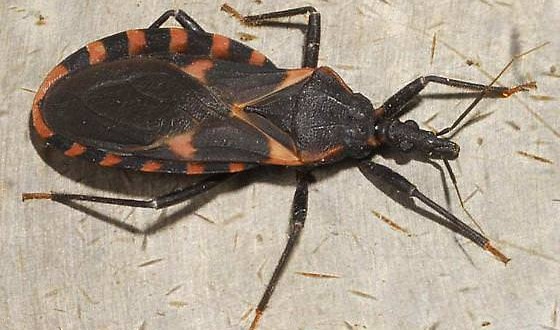KFDX, in a story posted July 27, reported that the insect that carries the deadly Chagas parasite is becoming a pest in Texas. The kissing bug, and Texas is home to seven species of the insect, is responsible for the spread of a parasite that can be deadly to humans. Chagas is endemic to much of Central and South America, though not the Caribbean, and can only be contracted in the Western Hemisphere.
“It’s worse this year because we’ve been in drought for the past few years and people are really collecting that water so we’ve had a lot of mosquitoes all over town,” Susan Morris with the Wichita Falls- Wichita County Public Health District says.
Morris said she received nearly 100 calls with mosquito complaints on Friday alone.
While the health department continues to tackle the problem and spray for mosquitoes all over the city, there’s concern rising throughout the state about another blood sucking bug.
“There are seven species of the kissing bug in Texas and we have one in this county,” Stephanie Fonville, a sanitarian in training at the health department, says.
A bug with a deadly bite known as the kissing bug has been popping up in parts of the lone star state.
This insect is normally found in Mexico and in other parts of Central America but researchers have found its presence in Texas is becoming more prominent.
The bug contains a deadly parasite known as T-cruzi that causes Chagas disease.
“It’s spread through their feces, so once they bite you, they rub their abdomen on you and it can spread through their feces through the wound,” Fonville says.
That’s how you can get the disease if the bug did carry it.
The bug has been found in the Dallas area, but local health department officials say so far they haven’t found any bugs in Wichita Falls that contain this disease..
Researchers at Texas A&M are continuing to search for the bug and are asking people all over Texas to keep their eyes peeled.
More information from Texas A&M:
Never touch a kissing bug with a bare hand. The parasite they may harbor can be transmitted to humans and other animals.
If you see a bug you believe is a kissing bug and would like confirmation of the species
identity and to submit it for testing, our lab accepts carefully obtained samples. Use a glove or small plastic bag to catch the bug to avoid direct contact with the bug.
Store the bug in a sealed plastic bag, in a vial, or other small container, all of which are acceptable. All surfaces with which the bug came into contact should be thoroughly
cleaned with a bleach solution. You may contact us (information on back) with questions or about submitting a kissing bug.
It is very important for us to know:
exactly where the bug was found
the date
the time of day
if the bug was alive when found
what the bug was doing
You can contact the research team:
[email protected]
(979) 458-4924
Agencies/Canadajournal
 Canada Journal – News of the World Articles and videos to bring you the biggest Canadian news stories from across the country every day
Canada Journal – News of the World Articles and videos to bring you the biggest Canadian news stories from across the country every day




I was Cleaning my dads house today, june 19 2016 in Niagara Falls Ontario. I went to open his front window and all along his windowsill were dead kissing bugs. its terrifying. I have googled the bug in canada and everything is old and about them being in Texas and no information about them being in Canada. I am both sickened and horrified that no news outlets or websites have anything about it. People need to be warned.
I have seen them at the old apartment I live at here in Calgary, not dead either, I guess it would be a good idea to send one off to the invasive species center.
http://www.invasivespeciescentre.ca/